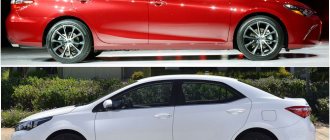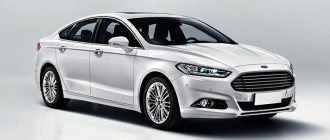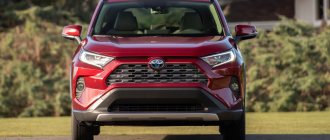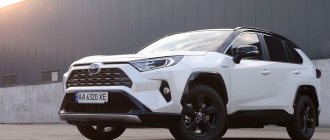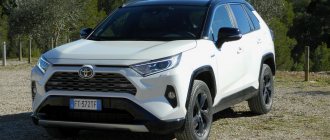In today's review we will talk about two long-time rivals who were breathing down each other's necks: first one, then the other. If you were asked which crossover is better: Toyota Rav 4 or Nissan X-Trail, what would you answer?
Surely, if you are quite familiar with each model, you would say: “Depends on the year.” Indeed, when discussing both brands' lineups up to 2012, the clear favorite was the Rav4. However, with the release of the new generation, everything went exactly the opposite - in almost all indicators, the X-Trail became a leader. This concerned design, optional equipment, comfort and even dynamics.
The breakthrough was due to the constant lag behind Toyota over many years, and the developers, tired of the eternal “second” place, turned the new model from catching up to leading. But this was, as we have already discussed, back in 2012. By 2021, both companies released restyled versions of their crossovers. Toyota tried to work on the mistakes and implement all its improvements, and Nissan intended to strengthen its once-occupied leading position. Who will be the favorite now? Let's get a look.
Appearance
The new Rav 4 body, released in 2012, was instantly criticized for its “femininity”. Indeed, not a trace of the former brutality remains. The car, in appearance, seems to be more suitable for the fair half of humanity. In contrast, the X-Trail's exterior was received with admiration. The aggressive “look” of the new LED lights, the massive V-shaped insert on the front grille, the slightly inflated rounded silhouette - all these elements together created the image of an adult, strong, solid, but at the same time modern crossover. The designers managed to combine courage and technology in one body. At the same time, he did not seem “chopped” and did not suffer from a “complex” of straight lines, unlike his classmate.
Four years later, Nissan's changes to the body are not particularly noticeable. They are certainly present, but do not significantly affect the image of the crossover, greatly changing it, unlike the pre-restyling version. Toyota has a more positive outlook. As we said, they worked on the bugs. New, now like the rival, LED headlights, additional bends of the hood and radiator grille add aggressiveness. The front design has been seriously redesigned. The face began to look prettier. But, according to many, the feeling of femininity still remains. Perhaps this is an aftertaste from the 2012 body, and buyers just need time to get used to it. However, for the domestic market this factor is to a certain extent a plus, since more and more women are switching from small cars to large crossovers.
To summarize the first part of the review, Nissan has the most attractive design that will find its connoisseurs among both men and women. Although the competitor was not far behind.
Interior and options
Comparing the 2012 models, according to these characteristics the X-Trail clearly won, but four years later the opponent caught up. At the moment, both brands have dashboards that are equal in ergonomics. At first glance, the Toyota “Torpedo” seems more modern and technically equipped. The car's temperament, which can be seen on the outside, is transmitted inside.
The Nissan salon has rounded, smooth lines that create the impression of comfort and lightness. Toyota's is more angular. The downside in both salons is the inaccessibility of certain buttons. The seat heating buttons for the first one are located on the central armrest, which requires the driver to be distracted from the road to adjust these indicators. And on the Rav4, these same buttons can be found at the very bottom of the central part of the dashboard. Moreover, they are located in such a way that you have to bend over to examine the position of the keys and press them correctly, and this certainly does not contribute to safe driving. Judging objectively, the Nissan dashboard is more convenient and ergonomic, although the advantage is again not great.
In terms of interior finishing materials, we can give equal advantages in terms of fat content, although for the Rav4 this sign will be stretched. The leather inside looks very beautiful and is pleasant to the touch. But everything is spoiled by the rather hard plastic, which looks cheap and does not blend well with the skin. But such subtleties are not for everyone.
The electronic functionality of both models is at the same level: heated seats, parking sensors, cameras. It is noteworthy that the 2012 X-Trail had a clear advantage - all-round visibility. Thanks to cameras around the perimeter of the body, the system displayed the image on the display in the form of a complete picture, “gluing” the fragments together. At the same time, the screen showed the car from above, and the driver could observe the movement of all existing objects around the car. Initially, Rafik did not have this option, but in the model we are considering, it became available in more expensive trim levels. Competition is the engine of progress!
The Rav 4's dashboard and numbers look brighter and larger, which will undoubtedly be appreciated by users with visual impairments. In Nissan's favor, we can note the convenient location of the all-wheel drive system switch. It looks like a rotatable “puck” and is located on the center armrest under the driver’s arm. With its help, you can easily adjust the suspension modes, of which there are three in the crossover:
- Front-wheel drive mode;
- Automatic front-wheel drive with possible connection of rear wheels (if the situation requires it);
- Forced all-wheel drive mode.
To carry out the same manipulations in a competitor, you need to delve into a lot of buttons and remember the correct sequence of pressing them. Very inconvenient.
The X-Trail has a dual-zone climate control function, which its opponent does not have. But the Rav 4 fends off its classmate’s attack by having heated rear seats, in which the above-mentioned function loses its use. A point for each opponent.
Sound insulation is also approximately the same in both cars. The Rav 4 model range, which rolled off the production line in 2012, was subject to serious criticism regarding this indicator. But the current model has corrected the errors of its younger brother.
In terms of space for passengers and seat comfort, everything is also about the same. Both the first and second rows of seats have sufficient space. The only difference is lateral stability in the front seats. Nissan is a little better. Although considering the presented class of cars, this indicator is not significant. We're not talking about sports cars. The X-Trail's rear seats slide back to create extra legroom for passengers, but this luxury comes at the expense of trunk space. By the way, Toyota clearly wins in terms of luggage capacity: 577 liters versus 497. In both brands, the rear seat backs fold down, providing more space, but this does not save Nissan. Toyota continues to lead: 1605hp. versus 1585l. If your priority is trunk space for fishing or hunting equipment, as well as a tent or suitcases, choose Rav 4.
Oval or square?
In the salons of our clients, the differences are the same as in their appearance. Nissan tries to smooth out the corners as much as possible so that there is nothing for the eye to catch on; Toyota, on the contrary, focuses attention on the details with its chopped surfaces and a large tablet towering in the center of the front panel. The climate control knobs look stylish. The analog-virtual “tidy” is also pleasing to the eye. And there are even more soft finishing materials here than in the rival.
In terms of ergonomics, the RAV4 beats its counterpart. Thus, the automatic window mode in the X-Trail is offered only for the driver's window, while in Toyota all four doors are equipped with it. True, both skimped on the illumination of the buttons for these same power windows, equipping only the driver’s window button with it. In terms of the diagonal size of the central screen, the RAV4 is in the lead, and in terms of response speed too, although in terms of picture quality (it must be said, low quality) the crossovers are the same. It would also be a good idea for Nissan to move the seat heating buttons from a blind spot near the center armrest to a more visible one.
In terms of driving position geometry, the competitors are identical. Drivers can easily find a comfortable driving position in both cars, but some of our experts complained about the steering column's lack of reach adjustment (again, in both). The Nissan seat is tighter and holds better in corners, but in the wide and rather soft Toyota seat you want not to drive, but to relax.
How long have we considered the X-Trail to be one of the best cars in the class for second-row space? We still think so. However, the RAV4 has even more space, although not by much. So, if a person 180 cm tall adjusts the front seat to suit him and sits back, then there will be a gap of about 15 cm in front of his knees in the Nissan and about 8 cm above his head. Toyota offers a couple of centimeters more in both directions.
And the sofa in the RAV4 is more comfortable: its padding is softer, its profile is better, and the seating is deeper. In the X-Trail you sit high, as if on a perch, on a short and hard cushion. In addition, Toyota passengers can take advantage of USB inputs, of which there are two on the second row. There is also an inclination of the backrests, but in a very small range. But in Nissan, on the contrary, the backrests are adjustable within a wider range. Both have center armrests with cup holders, as well as air vents located between the front seats.
According to the passport data, the luggage compartment of the RAV4 is 131 liters larger than that of its rival, and this is really noticeable. In addition, Toyota has a lower loading height, making it easier to load luggage into the car. But in the X-Trail you can move the sofa forward, increasing the space for luggage, but even in this case it will not reach the volume of the competitor. The backs of the sofas, of course, fold - both in Nissan and Toyota. Both crossovers have an electric rear door, and they have “docks” in the underground.
Engine and transmission
Toyota Rav 4 today is available in three types of engines:
- Petrol 2.0 l. power 146 hp;
- Petrol 2.5 l. power 180 hp;
- Turbodiesel 2.2 l. 150 hp
A classmate’s situation is approximately the same:
- Petrol 2.0 l. power 144 hp;
- Petrol 2.5 l. power 171 hp;
- Diesel 1.6 l. power 130 hp
As you can see, Toyota engines of the same type produce an order of magnitude more horses than those of their opponents. This cannot but affect speed performance. Acceleration from 0 to hundreds in the Rafik is a second faster, and the car feels more dynamic. But, as the old saying goes: you have to pay for everything in this life. And we’re not just talking about cost here, although we’ll definitely get to that. For more pleasant acceleration, SUV drivers will have to pay with higher fuel consumption. If Nissan in a combined cycle is capable of consuming 7-8 liters per hundred, then this is a serious task for an opponent. And if you accidentally turned on the “sport” mode, then you can’t count on less than 11 liters.
One of the biggest advantages of the Rav 4 is the presence of an automatic transmission, which its rival does not have. Nissan offers only a 6-speed manual, and both models have a CVT.
Toyota RAV4 II
RAV4 is one of those models that helped popularize SUV fashion. The second generation of the Japanese SUV appeared on the market in 2000, and three years later underwent modernization.
The design of the Toyota RAV4 made it especially popular among women. Today, interest in this model has dropped a little, but it still attracts many supporters.
The car was offered in 3-door and 5-door versions. Both options are not functional or practical enough. This especially applies to the smaller of them, which is suitable only for singles. For families, it is better to choose a crossover among 5-door modifications. But compared to the Honda CR-V, they seem rather unpretentious. The rear seat can change its position longitudinally, and the trunk has a capacity of 400-520/1365 liters.
The RAV4 with a 2-liter petrol engine is a completely reliable and dynamic car. Thanks to the relatively low weight of the Japanese all-terrain vehicle, this engine allows you to overcome even light off-road conditions.
The diesel D-4D, unfortunately, is best avoided: you have to deal with replacing the turbocharger and dual-mass flywheel. To make matters worse, the prices for spare parts are quite high.
The suspension is quite comfortable, but it lacks a bit of durability.
Despite the older age of most copies and lower functionality compared to its competitors, the RAV4 is quite expensive.
Controllability
If you drove the 2012 Rav 4, forget everything you felt. As we said, Toyota has done a tremendous amount of work on the mistakes, and it affected not only the aesthetic component, but also the technological one. I was very pleased with the handling of the 2021 model - a worthy competitor to its Japanese classmate. But it is worth noting that despite approximately the same behavior on the road, the driver gets completely different sensations while sitting behind the wheel.
A smooth, measured ride does not cause any differences in both cars. True, the gas pedal of the X-Trail is more responsive than that of the Rav 4. The engine, combined with a continuously variable transmission, operates confidently and gains smooth but rapid acceleration. On slippery surfaces, the rear wheels start working with a certain delay, but this is not very noticeable.
In contrast, its brother is almost free of slipping during a quiet ride. The all-wheel drive system is set up like a clockwork - the wheels start working accurately and on time. However, the gas pedal here has a large “dead zone”. She reacts slowly, as if hinting to the driver not to forget about safety. But everything can change dramatically when you turn on the “sport” mode. The acceleration becomes no less lively than that of the opponent.
Both competitors respond well to steering input, although the Toyota has a slight edge. Both have similar braking and cornering performance. But, as you remember, we looked at them during a quiet ride. What animals will burst out from under the hood of your rivals when you sharply press the gas and sharply throw into a turn?
On high-speed sections there is a huge difference in sensations. First, let's take a ride in the Toyota. Driving at the limit of a car's capabilities is accompanied by adrenaline, spark, enthusiasm, rapid heartbeat, dilated pupils, but not in this crossover. The Rav4 confidently takes turns, where it behaves calmly and sometimes even phlegmatically. Yes, the car is stable and reliable, but you won’t feel any pleasure. She misses life. This applies not only to crossovers - as a rule, all the latest models of the brand have an excessive amount of calm. But if marketers and engineers put an emphasis on security, then everything is in the black. And the choice is up to you.
Nissan is a completely different car. He is frisky, perky, fast. It pushes you in the back and throws you from side to side in turns, as if flirting with you and provoking you to drive even more aggressively. At the same time, the machine copes with sharp corners perfectly at any “sane” speeds. It’s as if he’s saying: “Come on, buddy! Show me what you can do." Here you will appreciate the advantage of deeper front seats and the presence of side locking. However, unlike Toyota, the X-Trail does not have a “sport” mode. On the one hand, this may seem like a minus, but considering that it is already full of energy, some will not pay attention to it.
Here we come, perhaps, to the most important point in terms of crossover controllability - passing obstacles. How off-road are both cars? At first glance, the X-Trail has a clear advantage - ground clearance. It is 210 mm versus 197 mm for the competitor, and the front overhang is 910 mm versus 940 mm. Further comparison also shows Nissan's leadership, although not significant. A well-designed all-wheel drive control system, regulated by the same rotary washer that was mentioned in the interior, helps to take leadership in this matter. But the weak link of this crossover is the variator, which overheats excessively under heavy loads and at low speeds ensures “digging” into loose snow. Toyota attracts with a 6-speed automatic, which will more reliably and predictably pull you onto hard surfaces.
Summarizing
It's hard to imagine more equal competitors than the Toyota Rav4 and Nissan X-Trail. They have no absolute disadvantages - what some would consider a minus, others would call an advantage. They are very similar, but incredibly different. The first is the standard of calm and confident driving, driving which your blood pressure will never rise, while the other flirts with you at every turn, improving your mood. But at the same time, they both cope well with all turns and obstacles, and also have the same stiffness suspension. The Rav has a roomy trunk, while the X-Trail has a more attractive interior. Nissan has a lower cost, but Toyota has a reputation. There is no winner in this duel, since it is impossible to compare a guitar and a violin to determine who is better. Each instrument plays individually beautifully, has advantages and has its own fans. Therefore, the choice is yours: Solid and balanced or Attractive and mischievous.
See also:
- Comparison of Nissan X-Trail and Mitsubishi Outlander
- What to take: Toyota Rav 4 or Mitsubishi Outlander?
- Which is better: Toyota Rav 4 or Honda SRV?
- Compare Mazda CX 5 and Toyota Rav 4
- Tiguan or Rav 4: West versus East
- Which is better: Rav 4 or Forester?
- Compare Kia Sportage and Toyota Rav 4
Comparison test - “How the Nissan X-Trail taught the Toyota RAV4 to corner”
An experienced “Japanese” taught his young compatriot lessons in good manners
The first foreign and Russian tests of the new Toyota RAV4 began almost with a scandal. The fact is that the car, in an attempt to quickly take a turn on a wet road, suspiciously easily went into a skid with the stabilization system activated, and in the “moose” test (rearrangement) on dry asphalt it stood on two wheels. Naturally, this behavior of the crossover was considered unsafe.
Well, let's try to figure out for ourselves whether the new RAV4 is dangerous or not. And the sparring match will be carried out by the owner of one of the best chassis in the class - the restyled Nissan X-Trail, which Russian engineers and testers were specially trained to drive on our roads.
Specifications
| Nissan X-Trail | Toyota RAV4 | |
| Body | ||
| Type | Station wagon (SUV) | Station wagon (SUV) |
| Number of seats/doors | 5/5 | 5/5 |
| Engine | ||
| Type | Petrol | Petrol |
| Engine location | Front transverse | Front transverse |
| Number and arrangement of cylinders | 4, in a row | 4, in a row |
| Working volume, cubic meters cm | 2488 | 2494 |
| Power, hp at rpm | 171/6000 | 180/6000 |
| Torque, Nm at rpm | 233/4000 | 233/4100 |
| Transmission | ||
| Drive unit | Full | Full |
| Transmission | CVT (CVT) | 6-automatic |
| Brakes | ||
| Front | Ventilated disc | Ventilated disc |
| Rear | Disk | Disk |
| Suspension | ||
| Front | Independent, spring, McPherson | Independent, spring, McPherson |
| Rear | Semi-independent, spring, multi-link | Semi-independent, spring, multi-link |
| Dimensions, volume, weight | ||
| Length/width/height, mm | 4640x1830x1715 | 4605x1845x1715 |
| Wheelbase, mm | 2705 | 2660 |
| Ground clearance, mm | 210 | 165 |
| Curb weight, kg | 1659/1701 | 1670–1705 |
| Fuel tank volume, l | 60 | 60 |
| Trunk volume, l | 497–1585 | 577–1605 |
| Tires | 225/60 R18 | 235/55 R18 |
| Dynamic characteristics | ||
| Maximum speed, km/h | 190 | 180 |
| Acceleration to 100 km/h, sec. | 10,5 | 9,4 |
| Fuel consumption, l/100 km | ||
| Combined cycle | 8,3 | 8,6 |
| CO2 emissions, g/km, eq. Class | 192/Euro-4 | 200/Euro-5 |
| Cost of the car, rub. | ||
| Basic equipment | 1 749 000 | 1 850 000 |
Safety and driver assistance systems
(+/-/O: yes/no/optional)
| Nissan X-Trail | Toyota RAV4 | |
| Front airbags | + | + |
| Side airbags | + | + |
| Curtain airbags | + | + |
| Driver/passenger knee airbag | –/– | +/– |
| Inflatable seat belts for rear passengers | – | – |
| ESP stabilization system | + | + |
| Traction control system TCS | + | + |
| Anti-lock braking system ABS | + | + |
| Brake Assist | + | + |
| Rear View Camera | ABOUT | ABOUT |
| Parktronic | ABOUT | ABOUT |
| Parking assistance system | ABOUT | ABOUT |
| LED headlights | ABOUT | ABOUT |
| Xenon headlights | – | – |
| Adaptive headlights | – | – |
| Lane Change Assistance System | ABOUT | ABOUT |
| Marking tracking system | ABOUT | ABOUT |
| Forward Collision Avoidance System | – | ABOUT |
| Traffic Sign Recognition System | – | ABOUT |
| Driver fatigue monitoring system | ABOUT | ABOUT |
| Turning on the hazard warning lights during emergency braking | + | + |
See all posts by tags: Nissan, Rav4, Toyota, X-Trail
Nissan of the future
In August, car spies spotted a prototype of the new X-Trail in camouflage. The SUV of the future was tested on American roads. Externally, the vehicle resembles the 2021 Xmotion. According to preliminary information, the base engine will remain a 2.5-liter four-cylinder with 172 horsepower. Also in the plans is a new 2-liter four with a capacity of 251 horses. The new product will appear on the market in 2021.
Nissan X-Trail
The new 2021 model year brought decorative changes to the exterior. The optics have grown a little in size. Now it is LED, which gives an increase in the beam compared to previous years. The rear ones were slightly tinted, giving them a new chic without losing visibility in the fog.
Inside, the steering wheel has become noticeably smaller. The steering wheel was even askew at the bottom. Sitting behind the wheel or in the back is even more fun thanks to heating in all known trim levels. True, there is a note of disappointment for rear passengers - the heating button is located between the front seats, access to the control area is limited.
Nissan X-Trail interior
The cargo compartment is very spacious. It can fit 5 full suitcases – one for each passenger. The trunk can be opened either electrically or by sliding it under the rear bumper. Experts note the convenience of this approach with busy hands. But in fact, this will not bring joy - after all, it is not clear what and how long it takes to open it.
Nissan X-Trail engine
Already in the basic configuration with a two-liter engine and manual transmission, a full package of active and passive safety is included - six airbags, child restraints. Comfort includes a multimedia system with limited functionality, heated front row seats and navigation via the Glonass network. Electronic assistants, LED lights, and a panoramic folding roof are optionally available. Opting for a color scheme other than white is worth paying extra.

